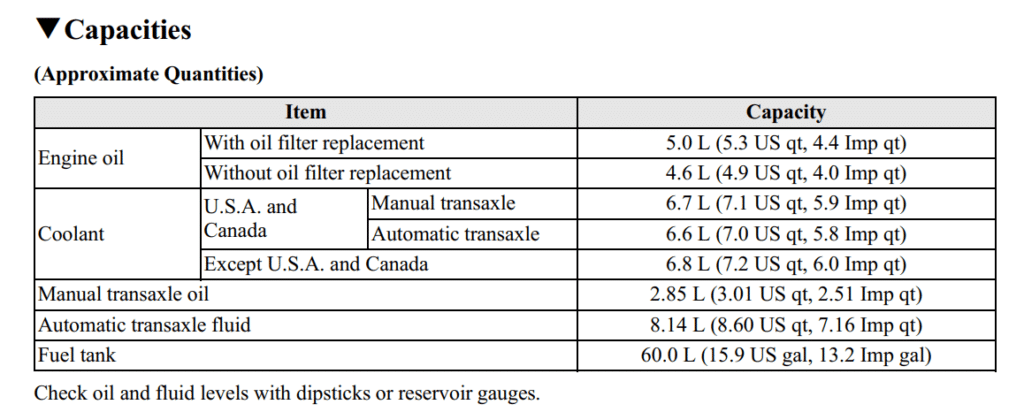The Mazda 5, known in some countries as the Mazda Premacy, entered the automotive scene as a compact minivan aiming to bring together the best of both worlds: the spaciousness of a minivan and the agility of a smaller car.
Key Takeaways:
- Importance of Transmission Fluid: The transmission fluid in your Mazda 5 plays a critical role in lubricating and cooling the transmission components, making it essential for the smooth running and longevity of your vehicle.
- Types of Fluids: For automatic transaxle, it is Mazda Genuine ATF M-V. Manual transaxle requires GL-4/GL-5 oil.
- Fluid Capacity: The Mazda 5’s automatic transmission fluid capacity varies by generation but is generally around 7.6 to 8.6 quarts for a complete change, including the torque converter.
- When to Replace: While mileage intervals (usually 30,000 to 60,000 miles) offer a good guideline, it’s essential to look out for signs of deteriorated fluid like slipping gears, delayed shifting, unusual noises, or dashboard warning lights.

Since its debut, it has attracted a broad spectrum of consumers, from families needing extra cargo room and seating to individuals looking for a versatile vehicle.
While it never boasted the size of some of its more gargantuan competitors in the minivan segment, it offered a more economical and maneuverable alternative. The unique sliding rear doors and the nimble handling made it stand out as a convenient, city-friendly family car.
Over the years, the Mazda 5 underwent several updates and facelifts, evolving through three generations, with the latest one, the 3rd Gen (CW), produced from 2012 to 2015.
As a Mazda 5 owner, you’re probably proud of your vehicle’s versatile nature and keen to keep it running smoothly for as long as possible. One of the most overlooked but crucial aspects of this is the car’s transmission system.
Your vehicle’s transmission is essentially the backbone of its operation, translating the engine’s power into movement. Like blood in the human body, transmission fluid serves as the life force that keeps this complex system running efficiently.
Understanding the type and capacity of transmission fluid your Mazda 5 requires can make a massive difference in its performance and longevity.
The right type of fluid will ensure that your vehicle’s gears shift smoothly while adhering to the correct capacity and preventing the risk of damaging your transmission through overheating or inadequate lubrication.
Failing to pay attention to these details could result in costly repairs, compromised safety, and even the complete breakdown of the vehicle.
2006-2015 Mazda Mazda5 Transmission Fluid Capacity And Transmission Fluid Type
Knowing the correct transmission fluid capacity is essential when you’re replacing or topping off the fluid in your Mazda 5.
An insufficient amount of fluid can lead to poor lubrication, while overfilling can cause other problems like foaming, which can lead to erratic shifting and other mechanical issues.
2006 – 2007 2nd Gen (CR)
For this early second-generation Mazda 5, the total transmission fluid capacity is approximately 7.5 to 7.8 quarts.

This amount is for a complete fluid change, including the fluid in the torque converter. If you’re only draining and refilling the transmission pan, you’ll need around 4 quarts.
| Gearbox | Fluid capacity | Fluid type |
|---|---|---|
| 4-speed automatic | Total fill: 7.6 quarts (7.2 liters) | Mazda Genuine ATF M-V |
| 5-speed automatic | Total fill: 8.6 quarts (8.1 liters) | Mazda Genuine ATF M-V |
| 5-speed manual | Total fill: 3 quarts (2.8 liters) | GL-4/GL-5 75W-90 |
2008 – 2010 2nd Gen (CR) Facelift
The facelifted second-generation models have a similar transmission fluid capacity to their earlier counterparts. For a full transmission fluid change, you’ll need about 8.6 quarts. If you’re just draining and refilling the transmission pan, expect to use around 3.5 to 4 quarts.
| Gearbox | Fluid capacity | Fluid type |
|---|---|---|
| 5-speed automatic | Total fill: 8.6 quarts (8.1 liters) | Mazda Genuine ATF M-V |
| 5-speed manual | Total fill: 3 quarts (2.8 liters) | GL-4 75W-80 |
2012 – 2015 3rd Gen (CW)
For the latest generation, the 3rd Gen (CW), the transmission fluid capacity is approximately 8 to 9 quarts for a complete fluid change, including the fluid in the torque converter.

If you are only draining and refilling the transmission pan, you’ll require around 3.5 quarts.
| Gearbox | Fluid capacity | Fluid type |
|---|---|---|
| 5-speed automatic | Total fill: 8.6 quarts (8.1 liters) Drain and refill: 3.2 quarts (3 liters) | Mazda Genuine ATF M-V |
| 6-speed manual | Total fill: 3 quarts (2.8 liters) | GL-4 75W-80 |
What is Transmission Fluid?
Transmission fluid plays a multifaceted role in your Mazda 5’s performance and long-term health. Essentially, it’s the liquid that lubricates, cools, and cleans the internal components of your vehicle’s transmission.
Think of it as the ‘oxygen’ that enables the ‘lungs’ of your vehicle—its transmission—to function optimally. Let’s delve into the roles it plays:
Lubricant
The transmission is made up of an array of gears, clutches, and bearings that need constant lubrication to function correctly.
The transmission fluid ensures that these components slide smoothly against each other, reducing friction and preventing wear and tear. Inadequate lubrication could result in the metal parts grinding against each other, leading to irreversible damage.
Cooling Agent
Transmissions generate a significant amount of heat due to the friction between the moving parts. The transmission fluid serves as a cooling agent, helping to disperse this heat and maintain a stable operating temperature.
An overheated transmission can lead to malfunction and even total failure, making the cooling property of the fluid invaluable.
Cleaning
As time passes, tiny metal shavings and other contaminants may accumulate in the transmission. Quality transmission fluid contains detergents that help clean these particles, keeping the transmission components in optimal condition.
Hydraulic Function
In automatic transmissions, the fluid also serves a hydraulic function. It helps facilitate gear shifts by activating the appropriate clutches and bands.
Without the correct fluid level or type, you may experience erratic or sloppy gear shifts, affecting your driving experience and potentially causing accidents.
For your Mazda 5, choosing the correct type of transmission fluid and maintaining the right capacity is crucial for ensuring smooth gear shifts, preventing overheating, and prolonging the lifespan of your transmission system.
Ignoring this important aspect of vehicle maintenance could lead to expensive repairs or even total transmission failure. So, as a responsible Mazda 5 owner, it’s crucial to understand the ins and outs of your vehicle’s transmission fluid needs.
When to Replace Transmission Fluid
Timely replacement of your transmission fluid is crucial for the longevity and efficient operation of your Mazda 5. Here, we’ll look into the mileage intervals for routine replacement and the signs indicating that your transmission fluid needs immediate attention.
Mileage Intervals
The general rule of thumb for most vehicles, including the Mazda 5, is to replace transmission fluid every 30,000 to 60,000 miles. However, it’s essential to consult your owner’s manual for the manufacturer-recommended intervals, as these may vary based on the specific model and driving conditions.
- 2006 – 2007 2nd Gen (CR): Generally, a fluid change every 40,000 to 50,000 miles is recommended.
- 2008 – 2010 2nd Gen (CR) Facelift: For these models, the recommendation stays consistent with earlier models—around 40,000 to 50,000 miles.
- 2012 – 2015 3rd Gen (CW): Given that this is a newer generation, some might opt for a 60,000-mile interval. However, frequent city driving or driving in hot climates might necessitate more frequent changes.
Signs That Your Transmission Fluid Needs Changing
Sometimes, despite keeping a keen eye on mileage intervals, your Mazda 5 may show symptoms that it’s time to replace the transmission fluid. Some of these signs include:
- Slipping Gears: If your vehicle unexpectedly changes gears or has difficulty staying in gear, this may be a sign of worn-out transmission fluid.
- Delayed or Erratic Shifting: Slow or rough shifts are often a symptom of degraded fluid that’s lost its lubricating properties.
- Unusual Noises: If you hear grinding or whining noises when the car is in gear, it’s a red flag that the transmission fluid is low or ineffective.
- Dashboard Warning Lights: Modern vehicles like the Mazda 5 come with transmission warning lights that may illuminate to signify an issue with your transmission fluid.
- Discolored or Burnt-smelling Fluid: Healthy transmission fluid is usually red and transparent. If it turns brown or gives off a burnt smell, it’s time for a replacement.
- Fluid Leaks: If you notice a puddle or spots of red or brown liquid under your vehicle, it may indicate a transmission fluid leak, requiring immediate attention.
Regularly checking the transmission fluid level and color using the dipstick can also help you gauge when a change is due. Poor-quality fluid should be replaced as soon as possible to prevent irreversible transmission damage.
How to Check Transmission Fluid Levels
Regularly checking the transmission fluid levels in your Mazda 5 can help you avoid many transmission-related issues. Here is a step-by-step guide on how to check the transmission fluid level. Always remember that safety comes first; if you’re not comfortable performing this task yourself, consult a professional mechanic.
Tools Needed
- Protective gloves
- A clean rag or paper towel
- Funnel (optional, for topping off)
Steps
1. Park on a Level Surface
Park your Mazda 5 on a level surface to ensure you get an accurate reading of the transmission fluid level. Turn off the engine.
2. Warm Up the Engine
Restart the engine and allow it to run until it reaches normal operating temperature. This helps circulate the transmission fluid through the system. Once warmed up, turn off the engine again.
3. Pop the Hood
Open the hood by pulling the hood release lever located inside the car, usually near the driver’s seat. Secure the hood with the hood prop rod.
4. Locate the Transmission Dipstick
The transmission dipstick is generally located towards the back of the engine compartment, often labeled or topped with a colored handle (often red or yellow).
5. Remove and Clean the Dipstick
Put on your protective gloves and carefully remove the dipstick. Wipe it clean using your rag or paper towel.
6. Insert and Remove the Dipstick Again
Insert the clean dipstick fully back into the transmission fluid tube and then pull it out again. Hold it horizontally for an accurate reading.
7. Check the Level and Condition
There will typically be two marks or notches on the dipstick, usually labeled “MIN” and “MAX.” Your fluid level should be between these two marks. The fluid should be a transparent red color. If it’s brown or has a burnt smell, you should consider replacing it.
8. Top Off If Necessary
If the fluid level is below the “MIN” mark, you’ll need to add more. Use a funnel to add the transmission fluid into the dipstick tube, taking care not to overfill. Remember to use the correct type of transmission fluid for your Mazda 5 generation.
9. Recheck the Level
After topping off, reinsert the dipstick, pull it out, and check the level again to ensure it’s now between the “MIN” and “MAX” marks.
10. Replace the Dipstick and Close the Hood
Once you’re done, securely place the dipstick back into its tube and close the hood.
How to Replace Transmission Fluid
Changing the transmission fluid is an essential part of maintaining your Mazda 5. Although this task is often left to professionals, those with a bit of automotive DIY experience may choose to do it at home. Below is a step-by-step guide on how to replace the transmission fluid in your Mazda 5. Always take safety precautions and if you’re unsure at any point, consult a professional.
Tools and Supplies Needed
- Protective gloves and eyewear
- Jack and jack stands or ramps
- Socket set and wrenches
- Drain pan
- Funnel
- New transmission fluid (check your owner’s manual for the recommended type)
- New transmission filter (optional)
- Torque wrench
- Clean rags or paper towels
Steps
1. Prepare Your Vehicle
Park your car on a level surface. Use a jack to lift the front of your vehicle and secure it with jack stands or ramps. Make sure the car is stable before proceeding.
2. Warm Up the Engine
Start the engine and let it run for a few minutes to warm up the transmission fluid, making it easier to drain. Turn off the engine after warming up.
3. Drain the Old Fluid
- Locate the transmission oil pan and position a drain pan beneath it.
- Remove the drain plug with the appropriate socket wrench and allow the fluid to drain into the pan.
- Wait until the fluid has completely drained out.
4. Remove the Transmission Pan (Optional)
If you’re also replacing the transmission filter, remove the bolts holding the transmission pan and gently lower it. This will expose the filter.
5. Replace the Filter (Optional)
Remove the old filter by unscrewing it or popping it out, depending on your model. Install the new filter and make sure it’s securely in place.
6. Clean the Transmission Pan
If you’ve removed it, clean the transmission pan thoroughly, removing any sediment or metal shavings. Also, clean or replace the pan’s magnet, which catches metal debris.
7. Reinstall the Transmission Pan and Drain Plug
If removed, reinstall the transmission pan, tightening the bolts in a crisscross pattern. Replace the drain plug and tighten it using a torque wrench to the specification in the owner’s manual.
8. Add New Transmission Fluid
- Position a funnel over the transmission dipstick tube and begin adding the new fluid.
- Pour in about half of the total capacity initially.
9. Start the Engine
Start your engine and let it run for a few minutes, shifting through all the gears to circulate the new fluid.
10. Check the Fluid Level
Turn off the engine and wait a few minutes. Use the dipstick to check the transmission fluid level, adding more if necessary. Do this until you reach the recommended capacity.
11. Test Drive and Recheck
Take your car for a short test drive to ensure the gears are shifting smoothly. After the test drive, recheck the fluid level one last time, adding more if needed.
12. Dispose of Old Fluid
Store the old fluid in a sealed container and dispose of it properly. Many auto parts stores offer free recycling services.
















